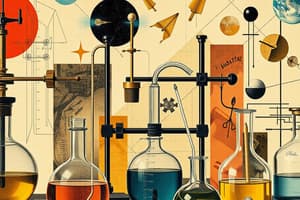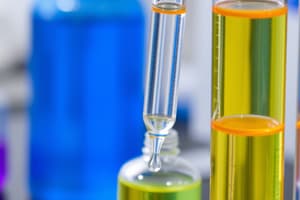Podcast
Questions and Answers
What is the purpose of a test tube brush?
What is the purpose of a test tube brush?
- Cleaning test tubes (correct)
- Delivering known volumes of a liquid
- Guiding liquid into a small opening
- Measuring temperature accurately
Which type of meniscus occurs when liquid molecules are more attracted to the container than to each other?
Which type of meniscus occurs when liquid molecules are more attracted to the container than to each other?
- Concave meniscus (correct)
- Flat meniscus
- Inverted meniscus
- Convex meniscus
In what type of container is a concave meniscus usually observed?
In what type of container is a concave meniscus usually observed?
- Thermometer
- Burette
- Graduated cylinder (correct)
- Funnel
What is a burette typically used for in laboratory experiments?
What is a burette typically used for in laboratory experiments?
What is the function of a funnel in laboratory experiments?
What is the function of a funnel in laboratory experiments?
What is the primary function of a mortar and pestle?
What is the primary function of a mortar and pestle?
What is the purpose of a separatory funnel?
What is the purpose of a separatory funnel?
Which piece of equipment is specifically designed to hold and contain chemicals at extremely high temperatures?
Which piece of equipment is specifically designed to hold and contain chemicals at extremely high temperatures?
What is the primary function of an Erlenmeyer flask?
What is the primary function of an Erlenmeyer flask?
What is the purpose of a separatory funnel adapter?
What is the purpose of a separatory funnel adapter?
Flashcards are hidden until you start studying
Study Notes
Laboratory Equipment
- Pipette: used to transfer a measured volume of liquid.
- Iron stand: used to mount iron rings and clamps in an experiment set-up.
- Tripod: a three-legged platform used to support flasks and beakers.
- Mortar and pestle: used to grind up solid chemicals into a fine powder and crush solids into smaller pieces.
- Tongs: used to grip and lift objects instead of holding them directly with hands.
- Spatula: a broad, flat blade used to mix, spread, and transfer solid chemicals.
- Evaporating dish: used for the evaporation of solutions; to separate liquids and solids from a solution.
- Watch glass: a circular convex concave piece of glass used as a surface to evaporate a liquid; to hold solids while being weighed or as a cover for a beaker.
- Erlenmeyer flask (conical flask or titration flask): a flask with a flat bottom, a conical body, and a narrow cylindrical neck.
- Florence flask (boiling flask): a flask with a round body with a long narrow neck and with either a round or a flat bottom.
- Stirring rod: used to mix chemicals and liquids.
- Clay triangle: used to hold crucibles and porcelain dishes heated by a Bunsen burner.
- Test tube: used to contain and test various reactions on a small scale; also known as a culture tube or sample tube.
- Beaker: a cylindrical container with a flat bottom and a small spout to aid pouring.
- Distilling flask: a flask used in distillation to separate mixtures of two liquids with different boiling points.
- Crucible and cover: used to contain chemicals when heated to extremely high temperatures.
- Test tube holder: used for holding a test tube in place when the tube is hot or should not be touched.
- Separatory funnel: used for liquid-liquid extractions, separating a mixture's components into two solvent phases of different densities.
- Separatory funnel adapter: used to connect various glassware items, usually when making various setups, like distillation, refluxing, sublimation, inert gas environment, vacuum, etc.
Temperature Measurement
- Thermometer: used to measure temperature.
- Conversion formula: ℉ = ℃ + 32, ℃ = ℉ − 32, 𝐾 = ℃ + 273.15.
Miscellaneous
- Test tube brush: used for cleaning test tubes.
- Graduated cylinder: a tall, narrow container with a volume scale used especially for measuring volume of liquids.
- Meniscus: a concave meniscus occurs when the molecules of the liquid are more strongly attracted to the container than to each other; a convex meniscus occurs when the molecules of the liquid are more strongly attracted to each other than to the container.
- Funnel: a tube or pipe that is wide at the top and narrow at the bottom, used for guiding liquid or powder into a small opening.
- Burette: a graduated glass tube with a tap at one end, for delivering known volumes of a liquid, especially in titrations.
Studying That Suits You
Use AI to generate personalized quizzes and flashcards to suit your learning preferences.




